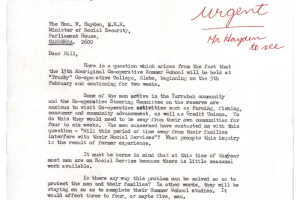
Artefacts about 1970s
As an Elder, Ruth Hegarty fought for justice on behalf of Aboriginal people in Queensland who had been denied access to government payments and fair wages. Her activism was spurred on by her own experiences.
As well as working with communities on government-run reserves in the Northern Territory, Vai Stanton Mimbinggal worked with the government to improve conditions for Aboriginal people nationally.
In the absence of government help, Aboriginal people often relied on their communities for support. Shirley Smith told her story of becoming an unofficial welfare worker while challenging stereotypes about those who got government payments.
Getting access to payments often relied on direct advocacy. Letters from the principal of an Aboriginal co-operative school provide examples.
After introducing payments for Aboriginal and Torres Strait Islander students, the government ran ads in magazines for Aboriginal audiences.
An article about a new Aboriginal study grant profiled 3 of its early success stories – people who would go on to be well-known public figures over the decades ahead.
Aboriginal workers walked off the Victoria River Downs cattle station in 1972 over pay and working conditions. The government was hesitant to pay Unemployment Benefit even though they passed the work test.
In response to questions about whether the government should further control payments for Aboriginal people, the Minister for Social Security discussed his concerns about the impacts payments were having, particularly on remote Aboriginal communities.







